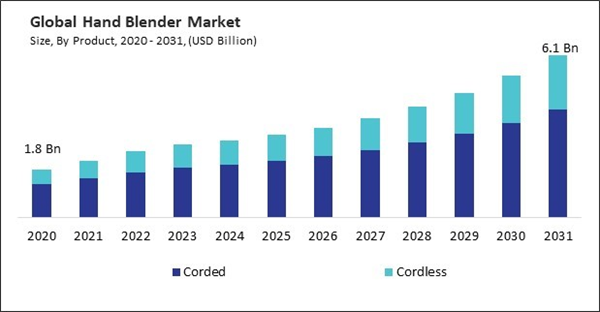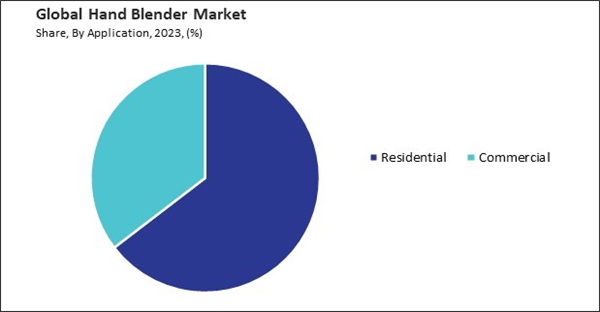The presence of major market players and the availability of a wide range of product options have driven the growth of the hand blender market in North America. The region’s emphasis on convenience and efficiency in cooking practices also supports the substantial revenue share. Thus, the North America region witnessed 38% revenue share in the hand blender market in 2023. In terms of volume the North America region is expected to utilize 51.55 million units of hand blender by 2031. This dominance can be attributed to the high disposable income of consumers, a strong culture of home cooking, and the widespread adoption of kitchen appliances in the region.
Urban households often experience fast-paced lifestyles due to long work hours, commuting, and various social commitments. As a result, there is a growing demand for kitchen appliances that simplify cooking and food preparation. Additionally, Millennials are increasingly viewing cooking not just as a necessity but as a creative outlet. This demographic is eager to experiment with different cuisines and culinary techniques, driving the demand for versatile kitchen tools like hand blenders. In conclusion, the expansion of culinary skills and home cooking among millennials is propelling the market's growth.
However, hand blenders, being electrical appliances, carry inherent electrical safety risks. Issues such as faulty wiring, poor insulation, or improper usage can lead to electric shocks or short circuits. The potential for electrical malfunctions creates anxiety among consumers, as they want to ensure their safety and that of their families while using kitchen appliances. Thus, the potential for overheating and safety risks hampers the market's growth.
Driving and Restraining Factors
Drivers
- Increasing demand for convenient and time-saving kitchen appliances in urban households
- Expansion of culinary skills and home cooking among millennials
- Rising e-commerce penetration and online retailing of kitchen appliances
Restraints
- Potential for overheating and safety risks
- Maintenance challenges and cleaning difficulties impacting user adoption
Opportunities
- Growing influence of social media and cooking shows on consumer choices
- Increasing adoption of hand blenders in commercial establishments
Challenges
- High competition from advanced kitchen appliances and food processors
- Discomfort with electrical setup and usage
Product Outlook
Based on Product, the market is divided into corded and cordless. In 2023, the corded segment garnered 69% revenue share in the market. In terms of volume, 128.39 million units of corded hand blenders are expected to be utilized by 2031. This dominance can be attributed to several factors, including the consistent power supply that corded hand blenders provide, ensuring uninterrupted operation during use.Application Outlook
On the basis of application, the market is segmented into commercial and residential. In 2023, the commercial segment attained 35% revenue share in the market. In terms of volume, 60.64 million units of hand blender in commercial application by 2031. The demand for hand blenders in commercial settings, such as restaurants, cafes, and catering services, has been driven by their utility in efficiently preparing large quantities of food.Distribution Channel Outlook
On the basis of the distribution channel the market is divided into online and offline markets by distribution channel. In 2023, the offline segment registered 74% revenue share in the market. In terms of volume, 115.53 million units of hand blenders are expected to be sold by offline distribution channel by 2031. This dominance is largely due to the traditional shopping preferences of many consumers who prefer to physically inspect and test appliances before purchasing.Regional Outlook
Region-wise, the market is analyzed across North America, Europe, Asia Pacific, and LAMEA. In 2023, the Asia Pacific region generated 24% revenue share in the market. In terms of volume the Asia Pacific region is expected to utilize 66.50 million units of hand blender by 2031. The growing middle-class population, increasing urbanization, and rising disposable incomes in countries like China, India, and Japan have significantly increased demand for hand blenders.List of Key Companies Profiled
- Robert Bosch GmbH (BSH Home Appliances Corporation)
- Koninklijke Philips N.V.
- Panasonic Holdings Corporation
- Whirlpool Corporation
- Wonderchef Home Appliances Pvt. Ltd.
- Breville Group Limited
- SMEG S.p.A.
- Hamilton Beach Brands, Inc. (Hamilton Beach Brands Holding Company)
- Cuisinart Corporation (Conair Corporation)
- Spectrum Brands Holdings, Inc.
Market Report Segmentation
By Product (Volume, Thousand Units, USD Billion, 2020-2024)
- Corded
- Cordless
By Application (Volume, Thousand Units, USD Billion, 2020-2024)
- Residential
- Commercial
By Distribution Channel (Volume, Thousand Units, USD Billion, 2020-2024)
- Offline
- Online
By Geography (Volume, Thousand Units, USD Billion, 2020-2024)
- North America
- US
- Canada
- Mexico
- Rest of North America
- Europe
- Germany
- UK
- France
- Russia
- Spain
- Italy
- Rest of Europe
- Asia Pacific
- China
- Japan
- India
- South Korea
- Singapore
- Malaysia
- Rest of Asia Pacific
- LAMEA
- Brazil
- Argentina
- UAE
- Saudi Arabia
- South Africa
- Nigeria
- Rest of LAMEA
Table of Contents
Companies Mentioned
- Robert Bosch GmbH (BSH Home Appliances Corporation)
- Koninklijke Philips N.V.
- Panasonic Holdings Corporation
- Whirlpool Corporation
- Wonderchef Home Appliances Pvt. Ltd.
- Breville Group Limited
- SMEG S.p.A.
- Hamilton Beach Brands, Inc. (Hamilton Beach Brands Holding Company)
- Cuisinart Corporation (Conair Corporation)
- Spectrum Brands Holdings, Inc.










